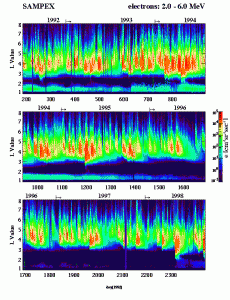Relativistic electrons: Long term measurements
The pleasantly surprising fact that SAMPEX has continued to operate well beyond its minimum design lifetime has provided a remarkable, long-term view of high-energy electrons throughout the Earth’s Van Allen radiation belts. The accompanying figure plots the logarithm of electron flux in the 2-6 MeV energy range as a color-coded representation. Data are plotted in terms of the magnetic “l-shell” parameter which is a measure of where a magnetic dipole field line would cross the magnetic equatorial plane. The L-values are scaled in terms of Earth radii, so L=3D1 is at the Earth’s equatorial surface, L=3D4 crosses the magnetic equator at 4 RE, and L=6.6 would map to the geostationary orbit in the magnetic equatorial plane.
The homogeneous data set shown in this figure (measured by one channel of the Proton-Electron Telescope [PET]) delineates very well the “outer” Van Allen belt (3 The data shown in the figure reveal powerful, 27-day recurrent electron acceleration events (due to high-speed solar wind streams) in 1993-95 for 3 It is fascinating to be able to get this kind of homogeneous, long timescale picture of Earth’s radiation environment. SAMPEX continues to provide a unique view of the terrestrial magnetospheric environment.
Contributed by Dan Baker, LASP, U of Colorado
«Return to the Results page
